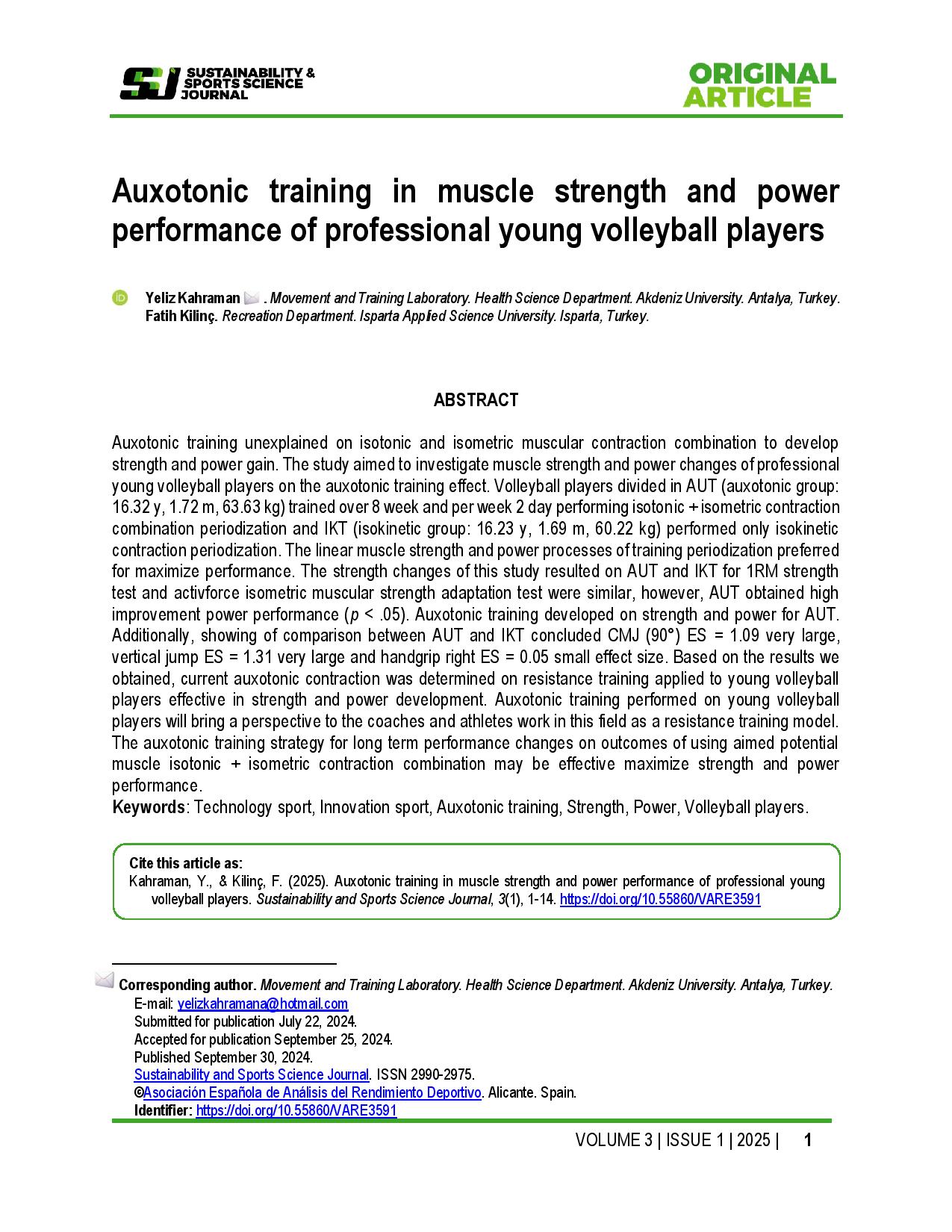Auxotonic training in muscle strength and power performance of professional young volleyball players
Main Article Content
Abstract
Auxotonic training unexplained on isotonic and isometric muscular contraction combination to develop strength and power gain. The study aimed to investigate muscle strength and power changes of professional young volleyball players on the auxotonic training effect. Volleyball players divided in AUT (auxotonic group: 16.32 y, 1.72 m, 63.63 kg) trained over 8 week and per week 2 day performing isotonic + isometric contraction combination periodization and IKT (isokinetic group: 16.23 y, 1.69 m, 60.22 kg) performed only isokinetic contraction periodization. The linear muscle strength and power processes of training periodization preferred for maximize performance. The strength changes of this study resulted on AUT and IKT for 1RM strength test and activforce isometric muscular strength adaptation test were similar, however, AUT obtained high improvement power performance (p < .05). Auxotonic training developed on strength and power for AUT. Additionally, showing of comparison between AUT and IKT concluded CMJ (90°) ES = 1.09 very large, vertical jump ES = 1.31 very large and handgrip right ES = 0.05 small effect size. Based on the results we obtained, current auxotonic contraction was determined on resistance training applied to young volleyball players effective in strength and power development. Auxotonic training performed on young volleyball players will bring a perspective to the coaches and athletes work in this field as a resistance training model. The auxotonic training strategy for long term performance changes on outcomes of using aimed potential muscle isotonic + isometric contraction combination may be effective maximize strength and power performance.
Article Details

This work is licensed under a Creative Commons Attribution-NonCommercial-ShareAlike 4.0 International License.
References
Andrews, A. W., Thomas, M. W., & Bohannon, R. W. (1996). Normative values for isometric muscle force measurements obtained with hand-held dynamometers. Physical therapy, 76(3):248-259. https://doi.org/10.1093/ptj/76.3.248
Azeem, Kaukab, and Erika Zemková. (2022). "Effects of isometric and isotonic training on health-related fitness components in young adults" Applied Sciences, 12(17):8682. https://doi.org/10.3390/app12178682
Clemons J. (2019). Construct Validity of Two different methods of scoring and performing push-ups. Journal of Strength and Conditioning Research, 33(11):2971-2980. https://doi.org/10.1519/JSC.0000000000002843
Comfort, P., Jones, P. A., Thomas, C., Dos'Santos, T., McMahon, J. J., & Suchomel, T. J. (2022). Changes in early and maximal isometric force production in response to moderate- and high-load strength and power training. Journal of strength and conditioning research, 36(3):593-599. https://doi.org/10.1519/JSC.0000000000003544
Delavier, F. (2001). Strength training anatomy. Human Kinetics.
Guppy, S. N., Kotani, Y., Brady, C. J., Connolly, S., Comfort, P., & Haff, G. G. (2022). The Reliability and magnitude of time-dependent force-time characteristics during the isometric midthigh pull are affected by both testing protocol and analysis choices. Journal of strength and conditioning research, 36(5):1191-1199. https://doi.org/10.1519/JSC.0000000000004229
Kahraman, Y. (2023). Is there any weakness in sports performance in volleyball athletes regarding the correlation between foot posture index and lower limb functional hopping performance?. Journal of the Foot & Ankle, 17(1):8-15. https://doi.org/10.30795/jfootankle.2023.v17.1678
Karagiannopoulos, C., Griech, S., & Leggin, B. (2022). Reliability and Validity of the ActivForce Digital Dynamometer in Assessing Shoulder Muscle Force across Different User Experience Levels. International journal of sports physical therapy, 17(4):669-676. https://doi.org/10.26603/001c.35577
Lee, S. E. K., Lira, C. A. B., Nouailhetas, V. L. A., Vancini, R. L., & Andrade, M. S. (2018). Do isometric, isotonic and/or isokinetic strength trainings produce different strength outcomes?. Journal of bodywork and movement therapies, 22(2):430-437. https://doi.org/10.1016/j.jbmt.2017.08.001
Lino-Samaniego, Á., de la Rubia, A., & Sillero-Quintana, M. (2022). Acute effect of auxotonic and isometric contraction evaluated by infrared thermography in handball players. Journal of thermal biology, 109,103318. https://doi.org/10.1016/j.jtherbio.2022.103318
Lum, D., Joseph, R., Ong, K. Y., Tang, J. M., & Suchomel, T. J. (2023). Comparing the effects of long-term vs. periodic inclusion of isometric strength training on strength and dynamic performances. Journal of strength and conditioning research, 37(2):305-314. https://doi.org/10.1519/JSC.0000000000004276
Muyor, J. M., Vaquero-Cristóbal, R., Alacid, F., & López-Miñarro, P. A. (2014). Criterion-related validity of sit-and-reach and toe-touch tests as a measure of hamstring extensibility in athletes. Journal of strength and conditioning research, 28(2):546-555. https://doi.org/10.1519/JSC.0b013e31829b54fb
Rhea M. R. (2004). Determining the magnitude of treatment effects in strength training research through the use of the effect size. Journal of strength and conditioning research, 18(4):918-920. https://doi.org/10.1519/14403.1
Vargas-Molina, S., Salgado-Ramírez, U., Chulvi-Medrano, I., Carbone, L., Maroto-Izquierdo, S., & Benítez-Porres, J. (2021). Comparison of post-activation performance enhancement (PAPE) after isometric and isotonic exercise on vertical jump performance. PloS one, 16:e0260866. https://doi.org/10.1371/journal.pone.0260866




